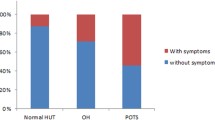Abstract
Orthostatic tolerance in 79 patients complaining of attacks of unexplained syncope, was assessed as the time to imminent syncope in a test involving: head-up tilt by 60° for 20 min, followed by tilt and lower body suction at −20 and −40 mmHg for 10 min at each. Blood pressure and heart rate were determined noninvasively. Ninety-five per cent of patients developed signs of presyncope during the test. After 10 min of lower body suction at −20 mmHg, presyncope had occurred in 85% of the patients compared with only 23% in a recently reported group of asymptomatic controls. Both patients and controls were divided into four groups: men and women, under and over 50 years, and the times at which each group of control subjects showed a 20% incidence of syncope were taken as the limits of normality. By those times, overall 85% of patients had developed syncope. It is concluded that the new combined test is able to discriminate patients who have poor orthostatic tolerance and is likely to be of value in assessing the effects of treatment regimes.
Similar content being viewed by others
References
Kenny RA, Ingram A, Bayliss A, Sutton R. Head-up tilt: a useful test for investigating unexplained syncope.Lancet 1986;i: 1352–1354.
Waxman MB, Yao L, Cameron DA, Wald RW, Roseman J. Isoproterenol induction of vasodepressor-type reaction in vasodepressor-prone persons.Am J Cardiol 1989;63: 58–65.
Almquist A, Goldenberg IF, Milstein S, Chen N-Y, Chen X, Hansen R, Gornick CC, Benditt DG. Provocation of bradycardia and hypotension by isoproterenol and upright posture in patients with unexplained syncope.New Engl J Med 1989;320: 346–351.
Hackel A, Linzer M, Anderson N, Williams R. Cardiovascular and catecholamines responses to head-up tilt in the diagnosis of recurrent unexplained syncope in elderly patients.J Am Geriat Soc 1991;39: 663–669.
Grubb BP, Temesy-Armos P, Hahn H, Elliot L. Utility of upright tilt table testing in evaluation and management of syncope of unknown origin.Am J Med 1991;90: 6–10.
Wahbha MMAE, Morley CA, Al-Shamma YMH, Hainsworth R. Cardiovascular reflex responses in patients with unexplained syncope.Clin Sci 1989;77: 547–553.
Fitzpatrick AP, Theodorakis G, Vardas P, Sutton R. Methodology of head-up tilt testing in patients with unexplained syncope.J Am Coll Cardiol 1991;17: 125–130.
Oberg B, Thoren P. Increased activity in left ventricular receptors during haemorrhage or occlusion of caval veins in the cat. A possible cause of the vasovagal reaction.Acta Physiol Scand 1972;85: 164–173.
Abboud FM. Ventricular syncope. Is the heart a sensory organ?New Engl J Med 1989;320: 390–392.
Al-Timman JKA, Hainsworth R. Reflex vascular responses to changes in left ventricular pressures, heart rate and inotropic state in dogs.Exp Physiol 1992;77: 455–469.
Fitzpatrick AP, Bannder N, Cheng A, Yacoub M, Sutton R. Vasovagal reactions may occur after orthotropic heart transplantation.J Am Coll Cardiol 1993;21: 1132–1137.
Stevens PM. Cardiovascular dynamics during orthostasis and influence of intravascular instrumentation.Am J Cardiol 1986;17: 211–218.
Kapoor WN, Brandt N. Evaluation of syncope by upright tilt testing with isoproterenol: a nonspecific test.Ann Intern Med 1992;116: 358–363.
El-Bedawi KM, Hainsworth R. Combined head-up tilt and lower body suction: a test of orthostatic tolerance.Clin Auton Res 1994;4: 41–47.
Day SC, Cook EF, Funkenstein H, Goldman L. Evaluation and outcome of emergency room patients with transient loss of consciousness.Am J Med 1982;73: 15–23.
Gendelman HE, Linzer M, Gabelman M, Smaller S, Scheuer J. Syncope in a general hospital patient population.NY State J Med 1983;83: 1161–1165.
Atkins D, Hanusa B, Sefcik J, Kapoor WN. Syncope and orthostatic hypotension.Am J Med 1991;91: 179–185.
Kapoor WN. Diagnostic evaluation of syncope.Am J Med 1991;90: 91–106.
Hamon DW, Ross BA. Head-up tilting in children who faint.J Paediat 1991;118: 731–732.
Grubb BP, Temesy-Armos P, Hahn H, Elliot L. Utility of upright tilt table testing in evaluation and management of syncope of unknown origin.Am J Med 1991;90: 6–10.
Grubb BP, Temesy-Armos P, Moore J, Wolfe D, Hahn H, Elliot L. The use of head-upright tilt-table testing in the evaluation and management of syncope in children and adolescents.Pace 1992;15: 742–748.
Raviele A, Gasparini DPF, Delise P, Bonso A, Piccolo E. Usefulness of head-up tilt in evaluating patients with syncope of unknown origin on negative electrophysiological study.Am J Cardiol 1990;65: 1322–1327.
Hainsworth R. Syncope and fainting. In: Bannister R, Mathias CJ, eds.Autonomic Failure: A Textbook of Clinical Disorders of the Autonomic System. 3rd edn. Oxford: Oxford University Press, 1992: 761–781.
Lewis T. Vasovagal fainting and the carotid sinus mechanism.Br Med J 1932;1: 873–876.
Abi-Samra F, Maloney JD, Fouad-Tarazi FM, Castle LM. The usefulness of head-up tilting and haemodynamic investigations in the work of syncope of unknown origin.Pace 1988;11: 1202–1214.
Chen XC, Chen MY, Remole S, Kobayashi Y, Dunnigan AM, Milstein S, Benditt D. Reproducibility of head-up tilt-table testing for eliciting susceptibility to neurally mediated syncope in patients without structural heart disease.Am J Cardiol 1992;69: 755–760.
Milstein S, Jeffery B, Lesser J, Goldenberg IF, Benditt DG, Gornick C, Reyes W. Cardiac asystole: a manifestation of neurally mediated hypotension-bradycardia.J Am Coll Cardiol 1989;14: 1626–1632.
El-Bedawi KM, Hainsworth R. Cardiac pacing does not change orthostatic tolerance in patients with vasovagal syncope.Clin Auton Res 1994;4: 233–237.
Author information
Authors and Affiliations
Rights and permissions
About this article
Cite this article
Hainsworth, R., El-Bedawi, K.M. Orthostatic tolerance in patients with unexplained syncope. Clinical Autonomic Research 4, 239–244 (1994). https://doi.org/10.1007/BF01827428
Received:
Accepted:
Issue Date:
DOI: https://doi.org/10.1007/BF01827428




